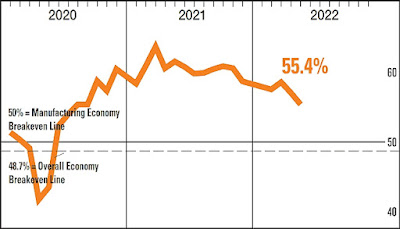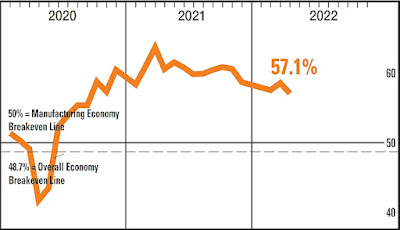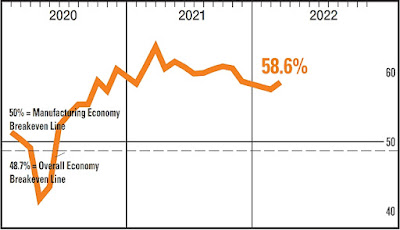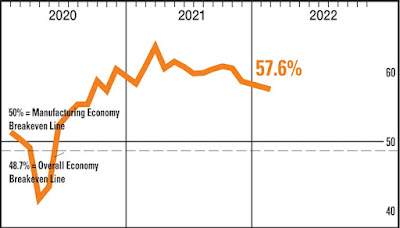ISM Manufacturing Index for DECEMBER 2025
=========
Predicted: 48.0%
- Actual: 47.9% (-0.3 point month-on-month change)
=========
Previous month: 48.2%
=========
Every month, the ISM surveys purchasing and supply executives at hundreds of companies across the country who are involved in manufacturing in some form. The resulting index is watched closely by academics, economists and investors because manufacturing accounts for about 12% of U.S. Gross Domestic Product (GDP).
The PMI is a reliable barometer of U.S. manufacturing: A PMI above 50% implies that U.S. manufacturing expanded during the month specified, while a reading below 50% implies that the made-in-the-USA sector contracted.
=========
"...Economic activity in the manufacturing sector contracted in December for the 10th consecutive month, following a two-month expansion preceded by 26 straight months of contraction, say the nation’s supply executives in the latest ISM® Manufacturing PMI® Report..."
=========
From A Diverse Pool Of U.S. Manufacturers:
- 'Winding up the year with mixed results. It has not been a great year. We have had some success holding the line on costs; however, real consumer spending is down and tariffs are ultimately to blame. I hope for some return to free trade, which is what consumers have ‘voted for’ with their spending.'
[Chemical Products]
- 'Trough conditions continue: depressed business activity, some seasonal but largely impacted by customer issues due to interest rates, tariffs, low oil commodity pricing and limited housing starts.'
[Machinery]
- 'Things are quieter regarding tariffs, but prices for all products remain higher. Our costs have increased, so we have increased prices for our customers to compensate. Margins have deteriorated, as full pass through (of cost increases) is not possible.'
[Computer + Electronic Products]
- 'Things are not improving in the transportation equipment market. Many customers are ordering for 2026, but those orders are 20 percent to 30% below their historical buying patterns. Some large fleets are still completely on hold for 2026, with zero capital expenditures money available to fleet budgets. Truck rental utilization, which is a good benchmark for the health of the economy, is still below historically stable levels. The general mood of the industry is that the first half of 2026 will be another bust, and we’re now hoping things pick up in the second half, even as the North American truck fleet continues to age.'
[Transportation Equipment]
- 'In the current environment, our company is struggling with customer orders and financially overall. Our senior leaders are struggling to focus our business and get the company on track with quality products. In November, layoffs impacted about 9% of our workforce, affecting all locations in the U.S. and Europe.'
[Machinery]
- 'Orders continue to drop for most of our businesses. Many plants are not running near full capacity. Make to order being utilized where possible.'
[Chemical Products]
- 'Order levels have continued to decline: We had a bad October, an awful November and a dismal December. January and February don’t look too good, as bookings are down 25 percent compared to the first two months of 2025.'
[Fabricated Metal Products]
- 'Morale is very low across manufacturing in general. The cost of living is very high, and component costs are increasing with folks citing tariffs and other price increases. It’s cold in our area of the country, absenteeism is worse around the holidays, and sales were lower than we expected for November. So, things look a bit bleak overall.'
[Electrical Equipment, Appliances + Components]
- 'Global logistics remains sensitive to geopolitical shifts. Tariffs are influencing equipment pricing and procurement strategies. Large-scale data center programs are absorbing and reducing availability of resources for other sectors.'
[Food, Beverage + Tobacco Products]
- '2025 revenue was down 17 percent due to tariffs. The lost revenue has inhibited our ability to offer bonuses to employees or create and hire for new positions.'
[Miscellaneous Manufacturing]
==========
Labels: FedPrimeRate, FedPrimeRate.com, hard_data, inflation, ism, manufacturing, pmi, purchasing_managers_index, Stagflation, Supply_Chain, tariffs, Trump_Tariffs
|
--> www.FedPrimeRate.com Privacy Policy <--
CLICK HERE to JUMP to the TOP of THIS PAGE > SITEMAP < |
















